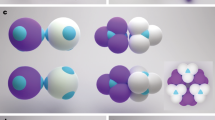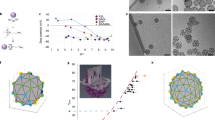Abstract
Three-dimensional photonic crystals, or periodic materials, that do not allow the propagation of photons in all directions with a wavelength in the visible region have not been experimentally fabricated, despite there being several potential structures and the interesting applications and physics that this would lead to1. We show using computer simulations that two structures that would enable a bandgap in the visible region, diamond and pyrochlore, can be self-assembled in one crystal structure from a binary colloidal dispersion. In our approach, these two structures are obtained as the large (Mg) and small (Cu) sphere components of the colloidal analogue of the MgCu2 Laves phase2, whose growth can be selected and directed using appropriate wall patterning. The method requires that the particles consist of different materials, so that one of them can be removed selectively after drying (for example, by burning or dissolution). Photonic calculations show that gaps appear at relatively low frequencies indicating that they are robust and open for modest contrast, enabling fabrication from more materials.
This is a preview of subscription content, access via your institution
Access options
Subscribe to this journal
Receive 12 print issues and online access
$259.00 per year
only $21.58 per issue
Buy this article
- Purchase on Springer Link
- Instant access to full article PDF
Prices may be subject to local taxes which are calculated during checkout




Similar content being viewed by others
References
Soukoulis, C. M. (ed.) Photonic Crystals and Light Localization in the 21st Century (NATO Science Series (C): Mathematical and Physical Sciences, Kluwer Academic, Dordrecht, 2001).
Pearson, W. B. The Crystal Chemistry and Physics of Metals and Alloys (Wiley-Interscience, New York, 1972).
Maldovan, M., Ullal, C. K., Carter, W. C. & Thomas, E. L. Exploring for 3D photonic bandgap structures in the 11 f.c.c. space groups. Nature Mater. 2, 664–667 (2003).
Moroz, A. Metallo-dielectric diamond and zinc-blende photonic crystals. Phys. Rev. B 66, 115109 (2002).
Garcia-Adeva, A. J. Band gap atlas for photonic crystals having the symmetry of the kagome and pyrochlore lattices. New J. Phys. 8, 86 (2006).
Ngo, T. T., Liddell, C. M., Ghebrebrhan, M. & Joannopoulos, J. D. Tetrastack: colloidal diamond-inspired structure with omnidirectional photonic band gap for low refractive index. Appl. Phys. Lett. 88, 241920 (2006).
Li, Z.-Y. & Zhang, Z.-Q. Fragility of photonic band gaps in inverse-opal photonic crystals. Phys. Rev. B 62, 1516–1519 (2000).
Tkachenko, A. V. Morphological diversity of DNA-colloidal self-assembly. Phys. Rev. Lett. 89, 148303 (2002).
Zhang, Z., Keys, A. S., Chen, T. & Glotzer, S. C. Self-assembly of patchy particles into diamond structures through molecular mimicry. Langmuir 21, 11547–11551 (2005).
Manoharan, V. N. & Pine, D. J. Building materials by packing spheres. Mater. Res. Soc. Bull. 29, 91–95 (2004).
Velikov, K. P., Christova, C. G., Dullens, R. P. A. & van Blaaderen, A. Layer-by-layer growth of binary colloidal crystals. Science 296, 106–109 (2002).
Vlasov, Y. A., Bo, X. Z., Sturm, J. C. & Norris, D. J. On-chip natural assembly of silicon photonic bandgap crystals. Nature 414, 289–293 (2001).
Frenkel, D. & Smit, B. Understanding Molecular Simulations (Academic, New York, 2002).
Mansoori, G. A., Carnahan, N. F., Starling, K. E. & Leland, T. W. Jr. Equilibrium thermodynamic properties of the mixture of hard spheres. J. Chem. Phys. 54, 1523–1525 (1971).
Speedy, R. J. Pressure and entropy of hard-sphere crystals. J. Phys. Condens. Matter 10, 4387–4391 (1998).
Hasaka, M., Nakashima, H. & Oki, K. Structure of the Laves phase observed in polystyrene latexes. Trans. Japan Inst. Met. 25, 65–72 (1984).
Yoshimura, S. & Hachisu, S. Order formation in binary mixtures of monodisperse latices. Prog. Colloid Polym. Sci. 68, 59–70 (1983).
Ma, G. H., Fukutomi, T. & Morone, N. Preparation and analysis of ordered structure of binary-mixtures composed of poly(4-vinylpyridine) and polystyrene microgels. J. Colloid Interface Sci. 168, 393–401 (1994).
Shevchenko, E. V., Talapin, D. V., Kotov, N. A., O’Brien, S. & Murray, C. B. Structural diversity in binary nanoparticle superlattices. Nature 439, 55–59 (2006).
Polson, J. M., Trizac, E., Pronk, S. & Frenkel, D. Finite-size corrections to the free energies of crystalline solids. J. Chem. Phys. 112, 5339–5342 (2000).
Pusey, P. N. et al. Structure of crystals of hard colloidal spheres. Phys. Rev. Lett. 63, 2753–2756 (1989).
Hoogenboom, J. P., Vossen, D. L. J., Faivre-Moskalenko, C., Dogterom, M. & van Blaaderen, A. Patterning surfaces with colloidal particles using optical tweezers. Appl. Phys. Lett. 80, 4828–4830 (2002).
Hoogenboom, J. P., van Langen-Suurling, A. K., Romijn, J. & van Blaaderen, A. Hard-sphere crystals with hcp and non-close-packed structure grown by colloidal epitaxy. Phys. Rev. Lett. 90, 138301 (2003).
Biswas, R., Sigalas, M. M., Subramania, G. & Ho, K.-M. Photonic band gaps in colloidal systems. Phys. Rev. B 57, 3701–3705 (1998).
Johnson, S. G. & Joannopoulos, J. D. Block-iterative frequency-domain methods for Maxwell’s equations in a planewave basis. Opt. Express 8, 173–190 (2001).
Wang, X., Zhang, X.-G., Yu, Q. & Harmon, B. N. Multiple-scattering theory for electromagnetic-waves. Phys. Rev. B 47, 4161–4167 (1993).
Moroz, A. Density-of-states calculations and multiple-scattering theory for photons. Phys. Rev. B 51, 2068–2081 (1995).
Busch, K. & John, S. Photonic band gap formation in certain self-organizing systems. Phys. Rev. E 58, 3896–3908 (1998).
Miguez, H. et al. Control of the photonic crystal properties of fcc-packed submicrometer SiO2 spheres by sintering. Adv. Mater. 10, 480–483 (1998).
Eiden-Assmann, S., Widoniak, J. & Maret, G. Synthesis and characterization of porous and nonporous monodisperse colloidal TiO2 particles. Chem. Mater. 16, 6–11 (2004).
Velikov, K. P. & van Blaaderen, A. Synthesis and characterization of monodisperse core-shell colloidal spheres of zinc sulfide and silica. Langmuir 17, 4779–4786 (2001).
Leunissen, M. E. et al. Ionic colloidal crystals of oppositely charged particles. Nature 437, 235–240 (2005).
Acknowledgements
We thank M. Megens for the MPB patch file and A. Moroz for useful discussions on KKR calculations and for providing the FORTRAN KKR code. This work is part of the research program of the ‘Stichting voor Fundamenteel Onderzoek der Materie (FOM)’, which is financially supported by the ‘Nederlandse Organisatie voor Wetenschappelijk Onderzoek (NWO)’. The work of E.C.M.V. is supported by NanoNed, a nanotechnology program of the Dutch Ministry of Economic Affairs. This work has been carried out within the framework of the SFB TR6 Collaborative Research Centre. On its inducement, it has been printed under appropriation of funds that were set at disposal by the DFG.
Author information
Authors and Affiliations
Contributions
A.-P.H. did the MC simulations under the supervision of M.D., J.H.J.T and E.C.M.V did the photonic bandgap calculations and A.v.B. initiated and supervised the project.
Corresponding authors
Ethics declarations
Competing interests
The authors declare no competing financial interests.
Rights and permissions
About this article
Cite this article
Hynninen, AP., Thijssen, J., Vermolen, E. et al. Self-assembly route for photonic crystals with a bandgap in the visible region. Nature Mater 6, 202–205 (2007). https://doi.org/10.1038/nmat1841
Received:
Accepted:
Published:
Issue Date:
DOI: https://doi.org/10.1038/nmat1841
This article is cited by
-
Formation of various structures caused by particle size difference in colloidal heteroepitaxy
Scientific Reports (2024)
-
Clustering of charged colloidal particles in the microgravity environment of space
npj Microgravity (2023)
-
Assembled crystal structures of cubic patchy colloid-droplet mixtures: theoretical prediction and simulation study
Colloid and Polymer Science (2023)
-
Binary icosahedral clusters of hard spheres in spherical confinement
Nature Physics (2021)
-
Total synthesis of colloidal matter
Nature Reviews Materials (2021)



